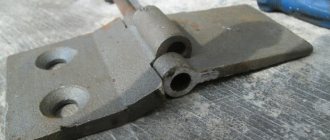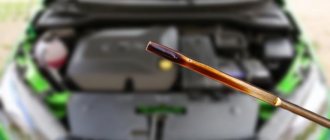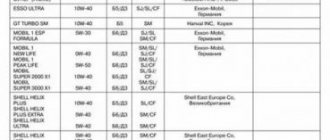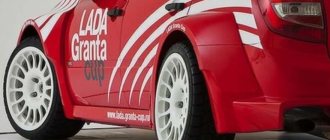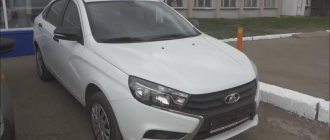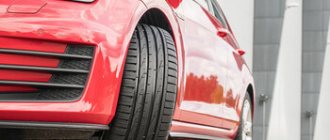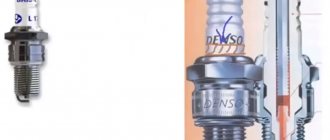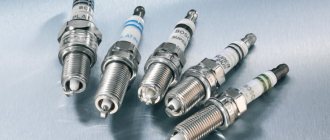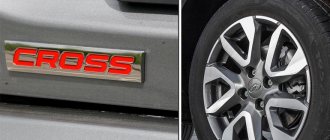Good day! In general, my rack rattled. I start tightening the nut, there is a little less noise, but the EUR no longer returns to zero after turning. I think it's a disc spring. I removed and disassembled the rack, changed the bushings, installed an ss20 plate, and lubricated everything generously. After installing the rack in place, I adjusted the nut so that the rack did not rattle. Started up and the steering wheel turns easily. Joyfully, I leave the garage and realize that while driving I have to manually return the steering wheel to zero. I went out onto the highway, and in order to steer, you need to overcome a certain force (you can feel the EUR torsion bar springing). I loosened it a little, no result. I weakened it even more, the roar was already wild, but there was a very bad feedback from the road. On the highway, more or less. The torsion bar is no longer so springy, but it still sucks. I suspect that the Makhachkala EUR is to blame. I tried pulling the fuse. THIS IS HARD... The steering wheel is made of oak and does not return to zero. It gets worse. I’m thinking of remaking the EUR for conventional mechanics: 1) Either break the worm and weld the torsion bar (budget) 2) or buy an assembled shaft and a mounting plate from a regular viburnum (expensive for me). If I choose the first option, will it be easier to turn the steering wheel than just pulling the fuse? Will there be a difference in steering effort between the first and second options? Maybe someone has a shaft from an ordinary viburnum lying around? or who will give it for inexpensively? I'm in Voronezh)
The process of adjusting the sensitivity of the EUR Makhachkala is described here. He turns the tuning resistor there. What do you think about this?
Share your thoughts and experiences! I will be grateful!
Electric power steering for modern cars has already become an integral part of them. On the Russian market it was first installed on the Lada Kalina ( VAZ 1118 ). The electric booster added both a lot of positive emotions and a lot of negative ones. Failure of this unit occurs quite often on the first samples. Our guest today was no exception – a car from the Lada “Kalina” family (Fig. 1).
The situation is quite typical: the client complains that sometimes the electric power steering turns off and the electric power steering warning light comes on, but after driving along some hole or rails, the electromechanical power steering (EMUR or EPS) resumes its operation.
This situation is very annoying, because not only the owner uses the car, but also his wife. It is much more problematic for a woman to turn the steering wheel without electric power assistance.
We start the car, and the electric power steering fault light actually lights up and it becomes quite difficult to turn the steering wheel. It is imperative to deal with this problem.
We connect the diagnostic scanner and connect to the EMUR control unit.
On the monitor screen we see the following error: C1044 – incorrect sequence of the rotor position sensor. What is a rotor position sensor and where is it located?
Let's take a break from our malfunction for a moment and touch on a little theory. Let's understand the EMUR device and what main parts it consists of. Let's consider all its parts separately.
Design EMUR Kalina 11186-3450008-00
- Steering shaft
- Electric motor
- Electronic control unit
- Torque sensor
- Rotor position sensor
We remove the EMUR. On the nameplate (Fig. 7) there is article number 11186-3450008-00 manufactured by Aviaagregat, Makhachkala.
Remove the steering wheel, steering column switches and ignition switch. To get to the torque sensor , you must first remove the electric motor. We unscrew the bracket with 4 bolts, the cardan shaft, the lock nut and the 3 bolts securing the electric motor.
This is what we got (Fig. 12)
Next we pull out the shaft.
We take out the torque sensor (Fig. 17), having previously unsoldered the wires from the board (Fig. 16).
Design of an inductive torque sensor.
The inductive sensor consists of two concentric cylinders with holes (perforation slots), which are fixed to the shaft and rotate with it. And two concentric coils with primary and secondary windings, fixedly inserted into the EMUR housing. We will not go into various terminology, but let’s put it simply: an alternating current with a frequency of 20 kHz is supplied to the primary winding, and if we apply force to the shaft (that is, we begin to rotate the steering wheel), then a voltage “+” or “-” appears on the secondary winding depending on the direction of rotation, and the magnitude of this voltage is directly proportional to the applied torque (force). Thus, the electronic control unit (ECU) determines with what force you rotate the steering wheel in one direction or another.
So, we’ve dealt with the torque sensor, let’s move on to the next one, namely the rotor position sensor (Fig. 20), which is located on the back cover of the electric motor.
The EMUR of the Lada "Kalina" uses a 3-phase switched inductor (brushless) motor. In order for it to start rotating in one direction or another, the electronics must understand what position the rotor is currently in and, after determining the position, apply voltage to certain stator windings at the right moments. To determine the position, a rotor position sensor (RPS) is used.
Causes of EUR failure
Why does the electric power steering on the Lada Kalina not work, turns off and refuses to work, what are the signs of a steering wheel with power steering knocking, jamming, biting or squeaking? To repair the system yourself, you need to know how diagnostics are carried out and what causes precede the breakdown. Most often, the failure of the amplifier is caused by a breakdown of the unit itself and the amplifier fails. Problems of this type are resolved by thoroughly checking the system to identify the exact problem.
As practice shows, often the inoperability of the electric amplifier (failure) is associated with a breakdown of the speed controller.
- the steering wheel is jammed,
- jams
- becomes tight
- and others
Because the speed controller sensor ensures activation and deactivation of the electric power steering under different driving modes. The amplifier on Kalina works if the car is moving at low speed. When the speed begins to increase, the booster automatically turns off, allowing for safer machine control when driving at high speeds.
So, briefly about the reasons for the inoperability of the EUR:
- The speed controller has failed or the control unit does not receive or disappears a signal from it. In this case, the reason may lie in either a breakdown of the sensor, damaged wiring, or poor contact of the controller with the on-board network.
- The voltage in the vehicle's electrical network has decreased. The reasons can be different, ranging from a dead battery and an inoperative generator to the use of inappropriate electrical equipment in the car.
- The permissible crankshaft speed has been exceeded.
- Incorrect operation or failure of the control module. Depending on the cause, the control unit may need to be repaired; more detailed diagnostics need to be done.
Knocking and creaking from the rear when braking on LADA cars
Have you ever encountered a situation where, when braking, extraneous noise appears from behind the car (knocks, impacts, squeaks)?
This problem can occur on any Lada car (for example, Kalina, Priora, Granta, Largus, Niva, Vesta or XRAY). Let's talk about possible solutions to this problem. Most often, extraneous noise from the rear when braking occurs when consumables are worn out (brake drums or pads No. 3). A knocking noise may occur when the pads are biting. When disassembling the brake drum, also pay attention to the condition of brake cylinder No. 1 , which may jam. We replace the pads with new ones.
In some cases, the culprit is worn tension springs No. 2 and No. 7 , which have stretched or burst over time. As a result, the normal operation of the rear brakes is disrupted.
Another reason for a knock at the rear may be the handbrake cable or its spring No. 14 that has jumped out . Inspect all the parts and tighten the handbrake.
Sometimes the cause of the problem may be a loose rear wheel bearing . In this case, noise (shuffling and tapping) from the rear appears during braking at low speed.
The last reason that many car owners have had to deal with is wheel bolts that are too long . For example, a longer wheel lock catches when braking and a knocking noise appears. Solution: replace it with a shorter one.
On B0 platform cars (Lada Largus, XRAY, Renault Logan, Sandero, etc.) over time, squeaking appears in the rear brake mechanisms. Reason: the pad is rubbing against the brake shield . We remove the clamp and remove the block, we see the place of wear. We clean these problem areas and lubricate them with grease. More details on the video:
Have you ever encountered a knocking noise from the rear when braking your car? How did you resolve this issue? We solve such problems in the comments or on the forum. And if the creaking noise when braking comes from the front, then most likely this noise is coming from the front brake pads, which should be replaced in pairs with better ones.
Diagnostics
To check the amplifier in a car, you need to remove the plastic trim on the steering column; to do this, unscrew the bolts securing it from the bottom.
Then you will need to get to the 8-pin plug, its pinout is as follows:
- The blue contact is connected to the ignition switch, this is 12 volt power;
- the red-brown contact is the connection cable to the tachometer;
- the gray contact goes to the car speed controller;
- white and pink wire - amplifier control indicator;
- black-yellow contact is a diagnostic line;
- the next contact is empty, the wire is not connected to it;
- brown contact is ground;
- empty.
More accurate results will be obtained by checking the amplifier using a scanner. But since such equipment can usually only be found at service stations, you can try to check the operation of the system with a paper clip.
To check you need to do the following:
- First the ignition is turned off.
- Then, using a paper clip, you need to close contacts numbered 6 and 7 of this plug, while the plug itself does not need to be removed.
- Next, the ignition must be turned on.
- After completing these steps, the EUR failure indicator located in the dashboard will begin to blink; by the number of blinks, you can determine whether the system is broken (the author of the video is Gosha Vakhromeev).
- one long signal and one short signal - the electric amplifier is working;
- one long and two short - no engine speed signal;
- one long and three short - the torque controller is out of order or there is no power supply;
- one long and four short blinks—problems in the operation of the electric power steering motor;
- one long and five short - the steering shaft position controller has failed;
- one long and six short - the motor rotor position controller has failed;
- one long and seven short - problems with the electrical network - the voltage is either too high or very low;
- one long and eight short - the control module of the electric amplifier has failed;
- one long and nine short - the speed controller is broken.
Why Lada Kalina (8 valves) does not start: reasons and solutions
If the car does not start and the starter does not turn, the reasons may be as follows:
- Discharged battery. It is not difficult to identify this: if the voltage in the battery is less than 12 V and a cracking sound appears when you try to start the car, this means that the battery is discharged. The problem can be easily fixed; just charge or replace the battery.
- Oxidation of terminals or loose fit. If the voltage drops when you start the car, there is a problem with the terminals. It is necessary to thoroughly clean the contacts and lubricate them with special Vaseline.
- The motor is jammed. By checking the rotation of the crankshaft, you can find out whether the power unit is working properly. To fix the problem, it is enough to repair it. Provided you have the knowledge and the necessary tools, you can actually do this yourself. You can also deliver the car to a service station.
- Problems with the starter. Often in this case you need to change it.
- The problem is in the starter circuit. To solve the problem, you need to replace the traction relay.
- Starter commutator burnout. Here, only replacement of this mechanism is required.
There are times when Kalina starts immediately, but then stalls. This malfunction can be caused by:
- damaged electrical connections of the ignition coil;
- low pressure in the fuel frame;
- leaky intake tract connections;
- faulty motor control system.
In general, there are a lot of reasons; the main thing is to identify them in time and begin to eliminate them.
Dismantling and disassembling the electric amplifier
Before removing the amplifier, you need to remove all the steering column switches. Remove the steering rack cover and dismantle the devices, remembering to disconnect the connectors from the power supply.
How to remove the EUR with your own hands:
- After removing the switches, you will need to dismantle the lower cross member of the dashboard. To do this, you need to press the fasteners that secure the connector with wires, and then disconnect the wiring from the control module. Once these steps are completed, you can disconnect the connector from the switches.
- The system bracket is secured with nuts; you will need to unscrew them with a wrench.
- After this, the steering rack will need to be carefully lowered down. To do this, you will need to find the bolt that secures the driveshaft to the booster shaft. This bolt must be unscrewed, but when unscrewing, you will need to fix the nut, this will prevent it from turning. When the bolt is removed, the fastening will need to be loosened, after which the intermediate shaft will be carefully removed. At this stage, we recommend marking the position of the shaft and gears; you can use a marker for this. This step is very important because doing it will prevent possible installation problems in the future. If the marks on the shafts do not match, this may cause problems with the amplifier. When dismantling, be careful not to damage the wiring, as this will also lead to the inoperability of the ESD.
- When the unit is dismantled, it will need to be disassembled and the failed elements replaced. Further editing is done in reverse order (the author of the video is Murzik Bely).
Spark plug
If everything is in order with the electronic filling, you should look for the problem in the candles. Often, and especially in winter, it floods.
Compression in the engine in cold weather does not meet the standards, so the engine may not start immediately. Often flooding of spark plugs occurs due to a discharged battery, which is unable to produce a normal spark. If not, the reasons may also be in the wiring or the spark plugs themselves. The easiest way to dry the spark plugs is to press the gas to the floor and crank the engine with the starter two or more times. Often, after this the car will start. If this does not help, then for more thorough drying you should dismantle the spark plugs, then clean them, check the gap, and then dry them with a hairdryer or in the oven.
How to tighten the electric power steering rack?
The appearance of a knocking sound in the operation of the electric power steering is associated with the need to tighten the steering rack.
How to do it right:
- First you need to disconnect the battery; to do this, disconnect the terminals from it. Unscrew the battery mount; to do this, you need to unscrew two more nuts located at the edges. After this, the battery is removed and put aside.
- Then you need to lift the plastic stand, there are four more screws under it, they can also be unscrewed.
- Having done this, it is necessary to move this stand forward until the platform is disconnected from the air filter housing retainer pad. After this, the trim can be moved back, this will provide freer access to the rail itself.
- At the next stage, you will need to crawl your hand under the rail. Directly below it, as shown in the photo, there is a rubberized cap; it will need to be removed, this will allow the key to access the adjusting nut.
- To perform adjustment work, you will need a special wrench to tighten the rack; without it, the adjustment procedure will not be possible. Using this wrench, you need to crawl under the car rail to install the tool in the required hole.
- When adjusting, be careful not to overtighten the rack. If its tightening is very strong, then when cornering the rack will bite, and this, in turn, may affect the safety of movement. The angle of adjustment is always different, it depends on how much the nut is loose, but usually when performing such work the nut is tightened by approximately 30 degrees. This should be enough to get everything right. After the adjustment is completed, it will be necessary to check that this task was performed correctly. That is, you will need to make sure that the steering wheel turns normally to any position all the way and there is no knocking. If the knock remains, then the adjustment continues.
Photo gallery “Adjusting the steering rack”
Knocking noise when braking from behind
Car : Lada Granta. Asks : Pavel. Brake system : Without ABS Symptoms : a knocking sound is heard in the area of the rear left wheel when braking.
A knocking sound appeared on a Lada Granta when braking. A knock is heard in the area of the rear left wheel. I thought I had torn off the brake pad lining, it was cold and the pads froze a couple of times. I removed the drum to replace the pads, and the linings are in place, the spacer bar also fits tightly and does not rattle.
I pulled the stabilizer, trailing arm, shock absorber, there were no knocks or play. I shook the suspended wheel in the horizontal and vertical planes, there was no knock. What else could it be?
How can I lubricate and adjust the EUR?
How and with what to lubricate the amplifier?
Litol can be used as a lubricant; the procedure is performed as follows:
- First you need to remove the plastic casing; to do this, unscrew the bolts that secure it. To unscrew, use a Phillips head screwdriver. It is also advisable to remove the lower cross member of the instrument panel, located under the steering wheel.
- Next, unscrew the two bolts that secure the amplifier itself; for this you will need a 13mm wrench. After this, the column can be released down.
- Unscrew another bolt, after which you can do the actual lubrication.
- First, the steering wheel is turned to the left until it stops. The lubricant is poured into a 10 cc syringe, which needs to be sprayed into the hole formed. You need to throw out all 10 cubes.
- Then the steering wheel is turned to the right until it stops - the syringe is again directed into the hole, all the lubricant is sprayed out.
- After this, the steering wheel should be turned to the middle position and again sprinkled with lubricant into the hole.
- Next, the steering wheel must be turned in different directions until it stops several times. The lubrication operation is repeated again.
- Then all the components are assembled in reverse order.
Fuel system
The first reason that a car may not start the first time is the fuel system. A missing amount of fuel or a very large supply of gasoline becomes a problem. Then the starter turns, unfortunately starting is difficult. If the starter does not turn and the immobilizer icon is flashing, then there is a problem with the unknown immobilizer.
See:
Fuel pump wear
A breakdown of the fuel pump or a clogged fuel filter may result in insufficient pressure in the fuel line and the mixture comes out lean. Accordingly, a small amount of fuel in the combustion chambers is not enough to start the engine . When a lot of fuel is supplied, the spark plugs are simply thrown and there is no spark to ignite, which is a prerequisite for the engine not starting.
vendor code
Standard Electric power steering VAZ 1118 (Kalina), Granta, Datsun On-Do (Mi-Do), Priora 11186-3450008-02, 1117-3450008-02
Manufacturer: Autoelectronics, Kaluga, Russia
Price 20,500 rubles
Brake disk
Often a knocking sound in the front wheel when braking occurs due to crooked discs. This occurs when overheating occurs. During the braking process, the pads, passing through the place where there is a bend, hit it, which causes a knock.
This problem can be treated, but it is quite difficult to accurately identify deviations from the norm without special equipment. If there are severe defects, of course, everything is visible visually, but then it is better to replace the disk with a new one. You can also grind the surface of the disk on a lathe or using special tools. It is better to replace the pads, otherwise after the disk is restored they will wear out on it again. Sometimes you can guess the curvature of a disc by the condition of the pads. They will wear unevenly.
Wheel problems
It is precisely problems with stingrays that cause the mentioned phenomenon in most cases. Let's consider them in descending order, according to the possible likelihood of their occurrence.
In 70% of cases of runout during braking at speed, wheel imbalance is to blame. Failure to adjust the ramp leads to the appearance of centrifugal force - the heavier part of the wheel pulls its center towards itself. The result is body shaking with vibration transferred to the steering wheel. The loss of one or more weights is determined simply: the beating appears at speeds greater than 60 km/h and when braking from there. When eliminating a defect, it is important not to make a mistake: correct balancing is carried out not on the pair of wheels where its violation was noticed, but on all 4.
The next most common reason is defects in tires and wheels. Flying into a hole or lateral collision with a curb disrupts the geometry of the latter, and the slope gives vibration not only to the steering wheel, but throughout the entire body. In some cases, it will not be possible to detect curvature visually. However, you can jack up the car and turn the wheel. If it is loose, take it to a tire shop and have it checked at a stand. As for tires, the culprit may be a manufacturing defect that led to the formation of lumps, or perhaps road damage to the cord.
Next in line is low tire pressure. It rarely happens to those who watch their wheels, but even the most attentive driver can run into a stud along the way. It is worth checking the pressure in the slopes and pumping them up to normal - perhaps such simple actions will immediately remove the beating.
Poor tightening of wheel bolts is a primitive reason, but often overlooked and, moreover, the cause of many accidents. Please note that it is possible for the bolts to spontaneously loosen while driving, say, on a “washboard”.
In any case, when runout occurs during braking, especially at high speeds, the wheels are carefully inspected first. If you were unable to find a defective one, go to a tire shop and entrust the diagnostics to professionals.
About DTOZH
In general, power unit temperature sensors are the most important regulators of an injection engine. There are two of them on it. One is located directly in the cylinder head, it displays the temperature value on the instrument panel.
The second one is located in the thermostat, and provides data on the temperature of the control unit of the power unit. Based on the results obtained, the control unit regulates the fuel supply - it supplies more fuel to a cold internal combustion engine, and less to a hot one. In addition, it is the control unit that regulates the OZ, influences the ignition of the fuel assembly, and activates the coolant fan if the liquid temperature rises above 100 °C.
Obviously, with faulty DTOZh there will be difficulties in the operation of the motor. However, this applies more to the DTOZH, which provides information directly to the block. For example, if the DTOZH is faulty, it will give false values about a cold engine, although it is already boiling. The supply of fuel to the cylinders will increase, because this is provided by the system. Let's say you drove for a long time, then stopped and went into a store. Now starting the power unit will cause obvious displeasure, since it will take a very long time to start due to data failures and oversaturation.
At the same time, the SOP, which is responsible for the ignition of a fuel assembly that is clearly over-enriched, changes greatly. As a result, the fuel will evaporate intensively, and the concentration of gasoline in the fuel assembly will be so high that the mixture will hardly ignite due to the small amount of oxygen.
It was said above that when you press the accelerator pedal, the startup time will be noticeably reduced. Now it becomes clear why this happens. By pressing the gas, we add oxygen to the fuel assembly, and the fuel ignites faster.
Source
